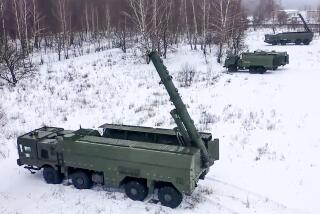U.S. Tests Nuclear Device Despite Soviet Warnings
- Share via
WASHINGTON — The U.S. government, brushing aside Soviet warnings of an intensified arms race, detonated a nuclear device Thursday at the sprawling Nevada test site.
The twice-postponed test, code-named Mighty Oak, was conducted without incident just after dawn, the Energy Department said.
The device, with the force of about 1,300 tons of TNT, was a relatively small one. Officials said the blast was intended to study the effects of nuclear explosions on U.S. weapons and space hardware, apparently as part of the effort to develop a “Star Wars” defense against ballistic missiles.
It was the first U.S. nuclear detonation since a unilateral Soviet test moratorium expired March 31. Soviet leader Mikhail S. Gorbachev announced late last month that Moscow would extend the moratorium indefinitely, provided that the United States refrained from exploding nuclear devices.
The official Soviet news agency Tass immediately denounced the Reagan Administration for the explosion, saying that it shows “criminal contempt” for American and world public opinion.
Tass did not say whether the Soviets would resume testing, but U.S. officials have no doubt that Moscow will do so at a time of its own choosing.
Hinting strongly at a resumption of testing, a commentator on the nightly Soviet television news, Vremya, said, “We regret this, but we shall have to do it as we cannot waive our own security and the security of our allies,” United Press International reported.
The Reagan Administration, which earlier had rejected Soviet test ban proposals, said the blast was a routine part of a continuing U.S. weapons test program. Officials said the decision to explode the device after postponements Tuesday and Wednesday was a technical one unrelated to diplomatic considerations.
“You are familiar with the U.S. position on nuclear tests,” State Department spokesman Bernard Kalb said when asked for comment on Soviet complaints. “I don’t have anything to add to that.”
The Soviet unilateral moratorium began Aug. 6. Moscow conducted seven tests last year before beginning its freeze. The United States announced 16 tests last year, seven of them after Aug. 6. Before Thursday, the most recent U.S. test had been conducted March 22.
Administration officials have said that such testing is necessary to maintain the reliability of existing weapons and to develop new ones. Washington maintains that a total test moratorium would retard the nuclear weapons development of both superpowers but probably would hurt the United States more than the Soviet Union because U.S. weapons are more sophisticated and require more testing.
Lawmaker Decries Test
Rep. Edward J. Markey (D-Mass.) issued a statement decrying the test.
“The only thing this test demonstrates is the Administration’s desire to spare itself the continuing arms control challenge posed by the Soviet test moratorium,” Markey said. “This may be one small boom in the desert, but it’s a big bomb for arms control.”
U.S. peace groups have demonstrated for three days at the test site 93 miles northwest of Las Vegas. Sixteen people, including two on Thursday, were arrested inside the facility and 89 demonstrators were seized at the gates to the site. All were charged with trespassing.
Twenty-two demonstrators stood just outside the boundary as the test was conducted. But the Energy Department said they were at least 40 miles from the explosion site and were in no danger. The blast was set off 1,300 feet underground.
Plans for Summit
If the test had been conducted as scheduled on Tuesday, it would have preceded by a just few hours President Reagan’s meeting with outgoing Soviet Ambassador Anatoly F. Dobrynin to discuss preliminary plans for the next Reagan-Gorbachev summit meeting.
However, U.S. officials said the postponement had nothing to do with summit diplomacy. They cited high winds Tuesday and Wednesday that could have carried radiation to Las Vegas and the Los Angeles area. Although underground tests are designed to contain all radiation, there have been leaks in the past.
More to Read
Sign up for Essential California
The most important California stories and recommendations in your inbox every morning.
You may occasionally receive promotional content from the Los Angeles Times.










